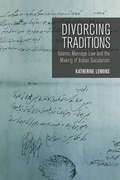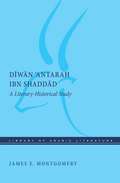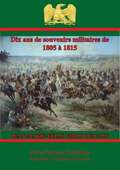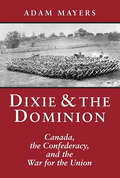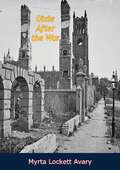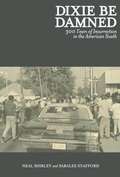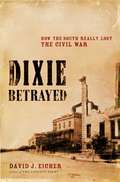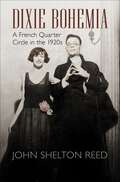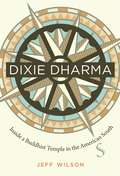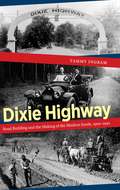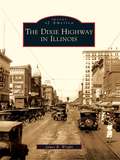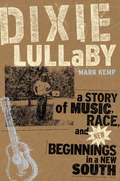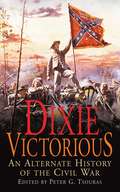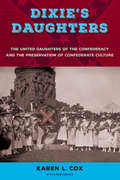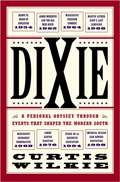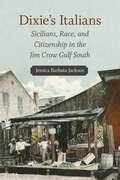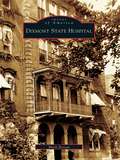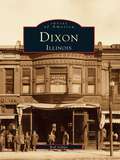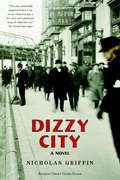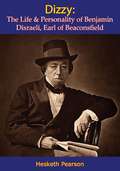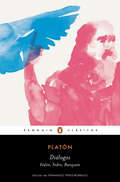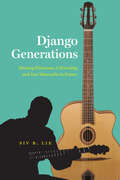- Table View
- List View
Divorcing Traditions: Islamic Marriage Law and the Making of Indian Secularism
by Katherine LemonsDivorcing Traditions is an ethnography of Islamic legal expertise and practices in India, a secular state in which Muslims are a significant minority and where Islamic judgments are not legally binding. Katherine Lemons argues that an analysis of divorce in accordance with Islamic strictures is critical to the understanding of Indian secularism. Lemons analyzes four marital dispute adjudication forums run by Muslim jurists or lay Muslims to show that religious law does not muddle the categories of religion and law but generates them. Drawing on ethnographic and archival research conducted in these four institutions—NGO-run women's arbitration centers (mahila panchayats); sharia courts (dar ul-qazas); a Muslim jurist's authoritative legal opinions (fatwas); and the practice of what a Muslim legal expert (mufti) calls "spiritual healing"—Divorcing Traditions shows how secularism is an ongoing project that seeks to establish and maintain an appropriate relationship between religion and politics. A secular state is always secularizing. And yet, as Lemons demonstrates, the state is not the only arbiter of the relationship between religion and law: religious legal forums help to constitute the categories of private and public, religious and secular upon which secularism relies. In the end, because Muslim legal expertise and practice are central to the Indian legal system and because Muslim divorce's contested legal status marks a crisis of the secular distinction between religion and law, Muslim divorce, argues Lemons, is a key site for understanding Indian secularism.
Divya
by Anand YashpalDivya leads a blissful life within the secure walls of the palace even as the world outside rages with caste politics and religious strife, until one night of pleasure changes her entire world. She gets pregnant only to be spurned by her lover.
Diwan 'Antarah ibn Shaddad: A Literary-Historical Study (Library of Arabic Literature #56)
by James E. MontgomeryThe pre-Islamic warrior-poet 'Antarah ibn Shaddad, a composer of one of the Mu'allaqat, attracted the attention of the philologists who were active in Iraq at the nascence of the scholarly study of Arabic. These philologists collected and studied the diwan of 'Antarah as part of their recovery and codification of the Jahiliyyah: 'Antarah became one of the Six Poets, a collection of pre-Islamic poets associated with al-Asma'i, “the father of Arabic philology.” Two centuries later, in al-Andalus, al-Shantamari and al-Batalyawsi composed their commentaries on the diwans of the Six Poets. This study uncovers the literary history of 'Antarah’s diwan and presents five editions, with critical apparatus, of the extant recensions, based on an extensive collation of the surviving manuscripts.An Arabic edition with English scholarly apparatus.
Dix ans de souvenirs militaires de 1805 à 1815
by Général Jean-Marie-Félix Girod De l'Ain« GIROD DE L'AIN (Jean-Marie-Félix), 1789-1874.Dix ans de souvenirs militaires de 1805 à 1815. Paris, Dumaine, 1873, in-8°,412 p.Nombreuses anecdotes sur l'Ecole militaire de Fontainebleau, la campagne de Prusse, l'Espagne (blocus de Cadix, mort du général Sénarmont, la campagne de Russie.» p 73 - Professeur Jean Tulard, Bibliographie Critique Des Mémoires Sur Le Consulat Et L'Empire, Droz, Genève, 1971
Dixie & the Dominion: Canada, the Confederacy, and the War for the Union
by Adam MayersDixie & the Dominion is a compelling look at how the U.S. Civil War was a shared experience that shaped the futures of both Canada and the United States. The book focuses on the last year of the war, between April of 1864 and 1865. During that 12-month period, the Confederate States sent spies and saboteurs to Canada on a secret mission. These agents struck fear along the frontier and threatened to draw Canada and Great Britain into the war.During that same time, Canadians were making their own important decisions. Chief among them was the partnership between Liberal reformer George Brown and Conservative chieftain John A. Macdonald. Their unlikely coalition was the force that would create the Dominion of Canada in 1867, and it was the pressure of the war - with its threat to the colonies’ security - that was a driving force behind this extraordinary pact.
Dixie After the War
by Myrta Lockett AvaryBased on eyewitness accounts, this book fully and graphically portrays the social conditions which existed in the South during the twelve year Reconstruction period following the downfall of the Confederate States of America. The author deals with such subjects as the oppressive military dictatorship to which the Southern people were subjected, the intrigue of the Loyal (Union) League, the tyranny of the Freedman's Bureau, the corruption of the Carpetbagger Governments, and the rise of Southern secret societies such as the Ku Klux Klan and the Knights of the White Camelia.-Print ed.
Dixie Be Damned: 300 Years of Insurrection in the American South
by Neil Shirley Saralee StaffordFar from the picturesque antebellum plantations and meekly repressed slaves of popular mythology, the American South has always had its share of social rebellion. Here, seven accounts of insurrectionary episodes in Southern history are tied together into a larger narrative about the long arc of revolt in the South. Countering images of the region as pacified and universally conservative, this adventurous alternative history covers slave rebellions, stockade burnings, multiracial banditry, labour struggles, prison uprisings, urban riots, and more.
Dixie Betrayed: How the South Really Lost the Civil War
by David J. EicherFor more than a century, conventional wisdom has held that the South lost the Civil War because of bad luck and overwhelming Union strength. The politicians and generals on the Confederate side have been lionized as noble warriors who bravely fought for states' rights. But in Dixie Betrayed, historian David J. Eicher reveals the real story, a calamity of political conspiracy, discord, and dysfunction that cost the South the Civil War. Drawing on a wide variety of previously unexplored sources, Eicher shows how President Jefferson Davis viciously fought with the Confederate House and Senate, state governors, and his own cabinet. Some Confederate senators threatened one another with physical violence; others were hopeless idealists who would not bend even when victory depended on flexibility. Military commanders were assigned not on the basis of skill but because of personal connections. Davis frequently interfered with his generals, micromanaging their field campaigns, ignoring the chain of command, and sometimes trusting utterly incompetent men. Even more problematic, some states wanted to set themselves up as separate nations, further undermining a unified war effort. Tensions were so extreme that the vice president of the Confederacy refused to live in the same state as Davis. Dixie Betrayed blasts away previous myths about the Civil War. It is essential reading for Civil War buffs and for anyone interested in how governments of any age can self-destruct during wartime.
Dixie Bohemia: A French Quarter Circle in the 1920s (Walter Lynwood Fleming Lectures in Southern History)
by John Shelton ReedIn the years following World War I, the New Orleans French Quarter attracted artists and writers with its low rents, faded charm, and colorful street life. By the 1920s Jackson Square had become the center of a vibrant if short-lived bohemia. A young William Faulkner and his roommate William Spratling, an artist who taught at Tulane University, resided among the "artful and crafty ones of the French Quarter." In Dixie Bohemia John Shelton Reed introduces Faulkner's circle of friends -- ranging from the distinguished Sherwood Anderson to a gender-bending Mardi Gras costume designer -- and brings to life the people and places of New Orleans in the Jazz Age.Reed begins with Faulkner and Spratling's self-published homage to their fellow bohemians, "Sherwood Anderson and Other Famous Creoles." The book contained 43 sketches of New Orleans artists, by Spratling, with captions and a short introduction by Faulkner. The title served as a rather obscure joke: Sherwood was not a Creole and neither were most of the people featured. But with Reed's commentary, these profiles serve as an entry into the world of artists and writers that dined on Decatur Street, attended masked balls, and blatantly ignored the Prohibition Act. These men and women also helped to establish New Orleans institutions such as the Double Dealer literary magazine, the Arts and Crafts Club, and Le Petit Theatre. But unlike most bohemias, the one in New Orleans existed as a whites-only affair. Though some of the bohemians were relatively progressive, and many employed African American material in their own work, few of them knew or cared about what was going on across town among the city's black intellectuals and artists.The positive developments from this French Quarter renaissance, however, attracted attention and visitors, inspiring the historic preservation and commercial revitalization that turned the area into a tourist destination. Predictably, this gentrification drove out many of the working artists and writers who had helped revive the area. As Reed points out, one resident who identified herself as an "artist" on the 1920 federal census gave her occupation in 1930 as "saleslady, real estate," reflecting the decline of an active artistic class. A charming and insightful glimpse into an era, Dixie Bohemia describes the writers, artists, poseurs, and hangers-on in the New Orleans art scene of the 1920s and illuminates how this dazzling world faded as quickly as it began.
Dixie Dharma
by Jeff WilsonBuddhism in the United States is often viewed in connection with practitioners in the Northeast and on the West Coast, but in fact, it has been spreading and evolving throughout the United States since the mid-nineteenth century. In Dixie Dharma, Jeff Wilson argues that region is crucial to understanding American Buddhism. Through the lens of a multidenominational Buddhist temple in Richmond, Virginia, Wilson explores how Buddhists are adapting to life in the conservative evangelical Christian culture of the South, and how traditional Southerners are adjusting to these newer members on the religious landscape. Introducing a host of overlooked characters, including Buddhist circuit riders, modernist Pure Land priests, and pluralistic Buddhists, Wilson shows how regional specificity manifests itself through such practices as meditation vigils to heal the wounds of the slave trade. He argues that southern Buddhists at once use bodily practices, iconography, and meditation tools to enact distinct sectarian identities even as they enjoy a creative hybridity.
Dixie Highway
by Tammy IngramAt the turn of the twentieth century, good highways eluded most Americans and nearly all southerners. In their place, a jumble of dirt roads covered the region like a bed of briars. Introduced in 1915, the Dixie Highway changed all that by merging hundreds of short roads into dual interstate routes that looped from Michigan to Miami and back. In connecting the North and the South, the Dixie Highway helped end regional isolation and served as a model for future interstates. In this book, Tammy Ingram offers the first comprehensive study of the nation's earliest attempt to build a highway network, revealing how the modern U.S. transportation system evolved out of the hard-fought political, economic, and cultural contests that surrounded the Dixie's creation.The most visible success of the Progressive Era Good Roads Movement, the Dixie Highway also became its biggest casualty. It sparked a national dialogue about the power of federal and state agencies, the role of local government, and the influence of ordinary citizens. In the South, it caused a backlash against highway bureaucracy that stymied road building for decades. Yet Ingram shows that after the Dixie Highway, the region was never the same.
Dixie Highway in Illinois, The
by James R. WrightThe Dixie Highway, once a main thoroughfare from Chicago to Miami, was part of an improved network of roads traversing the landscape of 10 states. A product of the Good Roads Movement of the early 20th century, construction on the highway in Illinois took place from 1916 to 1921. When completed in 1921, the Dixie Highway was the longest continuous paved road in the state. It ran through parts of Cook, Will, Kankakee, Iroquois, and Vermilion Counties, with service stations, roadside diners, and campgrounds sprouting up along the way. With over 200 vintage photographs, The Dixie Highway in Illinois takes readers on a tour from the Art Institute of Chicago, in the heart of the city on Michigan Avenue, to the Illinois state line east of Danville, exploring this historic highway and the communities it passes through.
Dixie Lullaby
by Mark KempRock & roll has transformed American culture more profoundly than any other art form. During the 1960s, it defined a generation of young people as political and social idealists, helped end the Vietnam War, and ushered in the sexual revolution. In Dixie Lullaby, veteran music journalist Mark Kemp shows that rock also renewed the identity of a generation of white southerners who came of age in the decade after segregation -- the heyday of disco, Jimmy Carter, and Saturday Night Live. Growing up in North Carolina in the 1970s, Kemp experienced pain, confusion, and shame as a result of the South's residual civil rights battles. His elementary school was integrated in 1968, the year Kemp reached third grade; his aunts, uncles, and grandparents held outdated racist views that were typical of the time; his parents, however, believed blacks should be extended the same treatment as whites, but also counseled their children to respect their elder relatives. "I loved the land that surrounded me but hated the history that haunted that land," Kemp writes. When rock music, specifically southern rock, entered his life, he began to see a new way to identify himself, beyond the legacy of racism and stereotypes of southern small-mindedness that had marked his early childhood. Well into adulthood Kemp struggled with the self-loathing familiar to many white southerners. But the seeds of forgiveness were planted in adolescence when he first heard Duane Allman and Ronnie Van Zant pour their feelings into their songs. In the tradition of music historians such as Nick Tosches and Peter Guralnick, Kemp masterfully blends into his narrative the stories of southern rock bands --from heavy hitters such as the Allman Brothers Band, Lynyrd Skynyrd, and R.E.M. to influential but less-known groups such as Drive-By Truckers -- as well as the personal experiences of their fans. In dozens of interviews, he charts the course of southern rock & roll. Before civil rights, the popular music of the South was a small, often racially integrated world, but after Martin Luther King Jr.'s assassination, black musicians struck out on their own. Their white counterparts were left to their own devices, and thus southern rock was born: a mix of popular southern styles that arose when predominantly white rockers combined rural folk, country, and rockabilly with the blues and jazz of African-American culture. This down-home, flannel-wearing, ass-kicking brand of rock took the nation by storm in the 1970s. The music gave southern kids who emulated these musicians a newfound voice. Kemp and his peers now had something they could be proud of: southern rock united them and gave them a new identity that went beyond outside perceptions of the South as one big racist backwater. Kemp offers a lyrical, thought-provoking, searingly intimate, and utterly original journey through the South of the 1960s, '70s, '80s, and '90s, viewed through the prism of rock & roll. With brilliant insight, he reveals the curative and unifying impact of rock on southerners who came of age under its influence in the chaotic years following desegregation. Dixie Lullaby fairly resonates with redemption.
Dixie Lullaby: A Story of Music, Race, and New Beginnings in a New South
by Mark KempRock & roll has transformed American culture more profoundly than any other art form. During the 1960s, it defined a generation of young people as political and social idealists, helped end the Vietnam War, and ushered in the sexual revolution. In Dixie Lullaby,veteran music journalist Mark Kemp shows that rock also renewed the identity of a generation of white southerners who came of age in the decade after segregation- the heyday of disco, Jimmy Carter, and Saturday Night Live. Growing up in North Carolina in the 1970s, Kemp experienced pain, confusion, and shame as a result of the South's residual civil rights battles. His elementary school was integrated in 1968, the year Kemp reached third grade; his aunts, uncles, and grandparents held outdated racist views that were typical of the time; his parents, however, believed blacks should be extended the same treatment as whites, but also counseled their children to respect their elder relatives. "I loved the land that surrounded me but hated the history that haunted that land," Kemp writes. When rock music, specifically southern rock, entered his life, he began to see a new way to identify himself, beyond the legacy of racism and stereotypes of southern small-mindedness that had marked his early childhood. Well into adulthood Kemp struggled with the self-loathing familiar to many white southerners. But the seeds of forgiveness were planted in adolescence when he first heard Duane Allman and Ronnie Van Zant pour their feelings into their songs. In the tradition of music historians such as Nick Tosches and Peter Guralnick, Kemp masterfully blends into his narrative the stories of southern rock bands- from heavy hitters such as the Allman Brothers Band, Lynyrd Skynyrd, and R.E.M. to influential but less-known groups such as Drive-By Truckers- as well as the personal experiences of their fans. In dozens of interviews, he charts the course of southern rock & roll. Before civil rights, the popular music of the South was a small, often racially integrated world, but after Martin Luther King Jr. 's assassination, black musicians struck out on their own. Their white counterparts were left to their own devices, and thus southern rock was born: a mix of popular southern styles that arose when predominantly white rockers combined rural folk, country, and rockabilly with the blues and jazz of African-American culture. This down-home, flannel-wearing, ass-kicking brand of rock took the nation by storm in the 1970s. The music gave southern kids who emulated these musicians a newfound voice. Kemp and his peers now had something they could be proud of: southern rock united them and gave them a new identity that went beyond outside perceptions of the South as one big racist backwater. Kemp offers a lyrical, thought-provoking, searingly intimate, and utterly original journey through the South of the 1960s, '70s, '80s, and '90s, viewed through the prism of rock & roll. With brilliant insight, he reveals the curative and unifying impact of rock on southerners who came of age under its influence in the chaotic years following desegregation. Dixie Lullaby fairly resonates with redemption.
Dixie Victorious: An Alternate History of the Civil War
by Peter G. TsourasEver wondered what would have happened if the Confederates had won the Civil War? This book not only says that it could have happened, but it also goes into detail to show you just how easily it could have-you're in for a shock! Written by military historian Peter G. Tsouras, Dixie Victorious examines a number of convincing scenarios, real battles, actions, and characters, and reveals how choices or minor incidents could have set in motion an entirely new train of events. This fascinating "what if" book will have you pondering how easily his-tory could have been swayed differently.
Dixie in the Big Pasture
by Belinda HurmenceIn 1908 thirteen-year-old Dixie's new life on the Oklahoma frontier is complicated by a war of nerves between her and John Three, a young Kiowa Indian who insists that his pony was sold to her without his permission.
Dixie's Daughters: The United Daughters of the Confederacy and the Preservation of Confederate Culture
by Karen L. CoxEven without the right to vote, members of the United Daughters of the Confederacy proved to have enormous social and political influence throughout the South--all in the name of preserving Confederate culture. Karen L. Cox's history of the UDC, an organization founded in 1894 to vindicate the Confederate generation and honor the Lost Cause, shows why myths surrounding the Confederacy continue to endure.
Dixie: A Personal Osyssey Through Historic Events That Shaped the Modern South
by Curtis Wilkie Colin JohDixie is a political and social history of the South during the second half of the twentieth century told from Curtis Wilkie's perspective as a white man intimately transformed by enormous racial and political upheavals. Wilkie's personal take on some of the landmark events of modern American history is as engaging as it is insightful. He attended Ole Miss during the rioting in the fall of 1962, when James Meredith became the first African American to enroll in the school. After graduation, Wilkie worked in Clarksdale, Mississippi, where he met Aaron Henry, a local druggist and later the prominent head of the Mississippi NAACP. He covered the Mississippi Freedom Summer of 1964 and the Mississippi Freedom Democratic Party challenge at the national convention in Atlantic City, and he was a member of the biracial insurgent Democratic delegation from Mississippi seated in place of Governor John Bell Williams's delegation at the 1968 convention in Chicago. Wilkie followed Jimmy Carter's campaign for the presidency, becoming friends with Billy Carter; he covered Bill Clinton's election in 1992 and was witness to the South's startling shift from the Democratic Party to the GOP; and finally, he was there when Byron De La Beckwith was convicted for the murder of civil rights leader Medgar Evers thirty-one years after the fact. Wilkie had left the South in 1969 in the wake of the violence surrounding the civil rights movement, vowing never to live there again. But after traveling the world as a reporter, he did return in 1993, drawn by a deep-rooted affinity to the region of his youth. It was as though he rejoined his tribe, a peculiar civilization bonded by accent and mannerisms and burdened by racial anxiety. As Wilkie writes, Southerners have staunchly resisted assimilation since the Civil War, taking an almost perverse pride in their role as "spiritual citizens of a nation that existed for only four years in another century. "Wilkie endeavors to make sense of the enormous changes that have typified the South for more than four decades. Full of beauty, humor, and pathos, Dixie is a story of redemption -- for both a region and a writer.
Dixie’s Italians: Sicilians, Race, and Citizenship in the Jim Crow Gulf South
by Jessica Barbata JacksonIn the late nineteenth and early twentieth centuries, tens of thousands of Southern Italians and Sicilians immigrated to the American Gulf South. Arriving during the Jim Crow era at a time when races were being rigidly categorized, these immigrants occupied a racially ambiguous place in society: they were not considered to be of mixed race, nor were they “people of color” or “white.” In Dixie’s Italians: Sicilians, Race, and Citizenship in the Jim Crow Gulf South, Jessica Barbata Jackson shows that these Italian and Sicilian newcomers used their undefined status to become racially transient, moving among and between racial groups as both “white southerners” and “people of color” across communal and state-monitored color lines.Dixie’s Italians is the first book-length study of Sicilians and other Italians in the Jim Crow Gulf South. Through case studies involving lynchings, disenfranchisement efforts, attempts to segregate Sicilian schoolchildren, and turn-of-the-century miscegenation disputes, Jackson explores the racial mobility that Italians and Sicilians experienced. Depending on the location and circumstance, Italians in the Gulf South were sometimes viewed as white and sometimes not, occasionally offered access to informal citizenship and in other moments denied it.Jackson expands scholarship on the immigrant experience in the American South and explorations of the gray area within the traditionally black/white narrative. Bridging the previously disconnected fields of immigration history, southern history, and modern Italian history, this groundbreaking study shows how Sicilians and other Italians helped to both disrupt and consolidate the region’s racially binary discourse and profoundly alter the legal and ideological landscape of the Gulf South at the turn of the century.
Dixmont State Hospital
by Mark BentonPittsburgh natives have recognized Dixmont State Hospital by its towering boiler house smokestack that stood prominently along busy Route 65. It has been a topic of curiosity, urban exploration, ghost hunts, and historical research; but prior to its closing in 1984, Dixmont State Hospital stood as a refuge to the mentally ill for three counties in western Pennsylvania. A majestic study in the Kirkbride design of asylum architecture, Dixmont was originally built by the Western Pennsylvania Hospital in 1859 as a private venture before being bought by the commonwealth. It was named for famed mental health care reformer Dorothea Dix, who was instrumental in choosing the hospital's site--a site chosen for its tranquility and its view of the Ohio River. Dixmont was completely razed in January 2006 to make way for a multi-parcel commercial endeavor. But for those who spent time there, Dixmont was a vibrant community within a community. Through historic photographs, Dixmont State Hospital opens up this world that was off limits to the general public but was alive with festivals, celebrations, and the successful treatment of patients.
Dixon, Illinois (Images of America)
by Bob GiblerThis fascinating new addition to the Images ofAmerica series offers a glimpse into the uniquehistory of Dixon, Illinois, with the use of over 200 historic photographs. In the spring of 1830, John Dixon settled with his family near the Rock River in Northern Illinois. Dixon, Illinois, soon grew as men crossed the river here on their way to work in the mines at Galena. In 1832, the Black Hawk War brought a number of now-famous men to this remote outpost of civilization. Winfield Scott, Zachary Taylor, Robert Anderson, Abraham Lincoln, and Jefferson Davis were all here, each of them equally unconscious of future immortal honors. The act of the Illinois General Assembly creating Lee County was approved February 27, 1839, with Dixon officially becoming the county seat on May 31, 1839. Dixon was on its way to fast becoming a central point in Illinois, well known for its industry, beautiful scenery, and the enchantment of the Rock River Valley.
Dizzy City
by Nicholas GriffinThe year is 1916, Europe is at war, and American industrialists are getting rich. Englishman Benedict Cramb deserts the trench warfare of northern France and stows away on an outbound transatlantic ship. When the ship docks in New York City, a place untouched and largely unaware of the horrors of war, he realizes this is the place to reinvent himself. In the process, he soon falls under the sway of the urbane and mysterious Julius McAteer, who sees in Ben his chance to finely hone the tools of someone who can master the art of the con. They concoct a ruse, pick their mark - a blustering midwestern cattleman named Henry Jergens - and the game is afoot. In the process, Ben falls in love with the beguiling actress Katherine Howells, who in turn is connected to even more men of vast means. But the further Ben follows the money in New York, the closer he moves back to the war in Europe and his shattering experiences there. This page-turner is rich in historical detail and filled with suspense, romance and adventure.
Dizzy: The Life & Personality of Benjamin Disraeli, Earl of Beaconsfield
by Hesketh PearsonDeservedly one of the outstanding biographers of our time, Hesketh Pearson turns in this book to perhaps the most fascinating, perplexing and dramatic figure of the Victorian age—a man who was equally famous as statesman, author and wit.Disraeli began political life with everything against him—his race, his disturbing wit, his love of pageantry and deliberately extravagant appearance, his passionate devotion to the traditions of aristocracy, coupled with a romantic temperament alien to the sober, middle-class atmosphere of his age. But through genius and undeviating self-confidence he lived to become an object of national reverence and affection in spite of ridicule from opponents and constituents alike.Pearson has penetrated the glittering parliamentary façade to give us the man himself. Side by side with that famous, sphinx-like figure who could hold the House of Commons spellbound during a three-hour speech, who brought England to the historic peak of her power, we have the character who danced a jig with his wife in their bedroom, wrote her daily notes, was inconsolable at her death, and eventually emerged from self-imposed isolation to fall in love at seventy with another man’s wife.Pearson uses his gift for quoting effectively and gives excerpts from letters, diaries, epigrammatic remarks and speeches so that the reader has the sense of having overheard actual conversations. He also comments with frankness upon Disraeli’s novels, which are interesting not only for their portraits of his contemporaries but their unconscious revelation of his character.Written with a wit and perception worthy of its subject, this is a brilliant recreation of the man whose personality was his genius.Richly illustrated throughout with 22 illustrations.
Diálogos: Fedón, Fedro, Banquete
by PlatónUna de las obras cumbre de la filosofía y la cultura occidental. «Se apoderó de mí el temor de quedarme completamente ciego de alma si miraba a las cosas con los ojos.» El presente volumen reúne tres diálogos fundamentales de Platón; tres de sus obras más leídas y comentadas, junto a La república . En Fedón, que tiene lugar durante las últimas horas de vida de Sócrates, Platón expone sus ideas en relación a la madurez y reflexiona sobre la inmortalidad del alma. Fedro, reconocido como uno de los diálogos platónicos más bellos, gira en torno al tema del amor. Este también se convierte en objeto de reflexión en Banquete, considerada una de las obras cumbres escritas sobre esta cuestión y en la que el diálogo se desarrolla a lo largo de una reunión de amigos e intelectuales. Este magnífico volumen presenta la traducción clásica de Luis Gil y María Arujo. Asimismo la edición está a cargo de Fernando Pérez-Borbujo, filósofo y profesor titular en la facultad de humanidades de la Universidad Pompeu Fabra de Barcelona.
Django Generations: Hearing Ethnorace, Citizenship, and Jazz Manouche in France (Chicago Studies in Ethnomusicology)
by Siv B. LieDjango Generations shows how relationships between racial identities, jazz, and national belonging become entangled in France. Jazz manouche—a genre known best for its energetic, guitar-centric swing tunes—is among France’s most celebrated musical practices of the twentieth and twenty-first centuries. It centers on the recorded work of famed guitarist Django Reinhardt and is named for the ethnoracial subgroup of Romanies (also known, often pejoratively, as “Gypsies”) to which Reinhardt belonged. French Manouches are publicly lauded as bearers of this jazz tradition, and many take pleasure and pride in the practice while at the same time facing pervasive discrimination. Jazz manouche uncovers a contradiction at the heart of France’s assimilationist republican ideals: the music is portrayed as quintessentially French even as Manouches themselves endure treatment as racial others. In this book, Siv B. Lie explores how this music is used to construct divergent ethnoracial and national identities in a context where discussions of race are otherwise censured. Weaving together ethnographic and historical analysis, Lie shows that jazz manouche becomes a source of profound ambivalence as it generates ethnoracial difference and socioeconomic exclusion. As the first full-length ethnographic study of French jazz to be published in English, this book enriches anthropological, ethnomusicological, and historical scholarship on global jazz, race and ethnicity, and citizenship while showing how music can be an important but insufficient tool in struggles for racial and economic justice.
